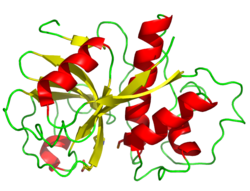Papain
| Papain | ||
|---|---|---|

|
||
|
Existing structural data : 1cvz , 1khp , 1pad , 1pip , 1pop , 1ppd , 1stf , 2cio , 2pad , 4pad , 5pad , 6pad , 9pap |
||
| Mass / length primary structure | 212 amino acids | |
| Identifier | ||
| External IDs |
|
|
| Enzyme classification | ||
| EC, category | 3.4.22.2 , peptidase | |
| MEROPS | C01.001 | |
| Response type | hydrolysis | |
| Substrate | Peptides - / - / l / r + Q / Q / - / D | |
| Products | Peptides | |
Papain is an enzyme that occurs naturally in relatively high concentrations in the greenish skin and the kernels of the fruit fruit papaya and is extracted from it. It is essential for the plant in repelling pests.
The enzyme has a broad protein-splitting effect and belongs to the group of cysteine proteases . It is used in the kitchen as a tenderizer for meat. In textile technology, papain is used as an aid in the production of wool and silk to prevent matting and shrinking.
history
The indigenous peoples of Central and South America used the milky sap of papaya to clean soiled wounds . The oldest records of this are in "Natural history of Barbados" by Griffith Hughes, 1750, and "Civil and natural history of Jamaica" by Patrick Browne , which was written in 1756.
The enzymatic activity of papaya fruit juice was discovered in 1878. In 1879 Adolf Wurtz and Eugène Bouchout were able to isolate the enzyme.
In 1950 Robert Ammon and Hans-Adolf Oelkers found out that papain has vermicidal ( worm- killing) properties.
The protein structure was one of the first to be elucidated in 1968. The complete amino acid sequence of papain was deciphered in 1969.
application
In transfusion medicine , papain can be used to identify the Duffy factor . It also has antimicrobial and antioxidant effects (in conjunction with other ingredients in unripe papaya).
As a therapeutic agent in alternative medicine , papain is ascribed healing effects in healing a disease (so-called " open leg ") in the initial stage. Papain is also said to break down fibrin on the inner walls of the blood vessels, so that the frequency of thrombosis is reduced. It is said to have a whitening effect on teeth. However, there are insufficient experimental results for the effects described.
In addition, papain is used in zoological preparation as a maceration agent .
Individual evidence
- ↑ Konno K, Hirayama C, Nakamura M, et al : Papain protects papaya trees from herbivorous insects: role of cysteine proteases in latex . In: Plant J . 37, No. 3, February 2004, pp. 370-8. PMID 14731257 .
- ^ A b c Wolf-Dieter Müller-Jahncke , Christoph Friedrich , Ulrich Meyer: Medicinal history . 2nd, revised and completed edition. Wissenschaftliche Verlagsgesellschaft mbH, Stuttgart 2005, ISBN 978-3-8047-2113-5 , p. 109 .
- ↑ Wittmack, H .: The fermentative action of the juice of the fruit of Carica papaya. Pharm J Trans (1878) 9, 449.
- ↑ Wurtz, A. and Bouchut, E .: Sur le ferment digestif du Carica papaya. CR Acad Sci Hebd Seances Acad Sci D (1879) 89, 425-430.
- ↑ Drenth J, Jansonius JN, Koekoek R, Swen HM, Wolthers BG: Structure of papain . In: Nature . 218, No. 5145, June 1968, pp. 929-32. doi : 10.1038 / 218929a0 . PMID 5681232 .
- ↑ Husain SS, Lowe G: Completion of the amino acid sequence of papain . In: Biochem. J. . 114, No. 2, September 1969, pp. 279-88. PMID 4898282 . PMC 1184853 (free full text).
- ↑ University Hospital Würzburg, Lecture on Transfusion Medicine ( Memento from January 26, 2011 in the Internet Archive ).
- ↑ JA Osato, LA, Santiago, GM Remo, MS Cuadra, A. Mori: Antimicrobial and antioxidant activities of unripe papaya. In: Life Sciences 53 (1993) 17, pp. 1383-89.
- ↑ Federal Gazette of August 25, 1994, issue number. 160, ATC code P02CX .